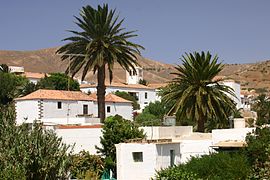Betancuria
| Betancuria municipality | ||
|---|---|---|
 Betancuria from the north
|
||
| coat of arms | Map of the Canary Islands | |

|
|
|
| Basic data | ||
| Autonomous Community : | Canary Islands | |
| Province : | Las Palmas | |
| Island: | Fuerteventura | |
| Coordinates | 28 ° 25 ′ N , 14 ° 3 ′ W | |
| Height : | 395 msnm | |
| Area : | 103.64 km² | |
| Residents : | 758 (Jan 1, 2019) | |
| Population density : | 7.31 inhabitants / km² | |
| Postal code : | E-35637 | |
| Municipality number ( INE ): | 35007 | |
| administration | ||
| Mayor : | Marcelino Cerdeña ( CC ) (as of 2007) | |
| Address of the municipal administration: | C / Amador Rodríguez, 2 35637 - Betancuria |
|
| Location of the municipality | ||

|
||
Betancuria is one of the six municipalities on to Spain belonging Canary Island Fuerteventura . The village of Betancuria as its administrative center is considered to be the most historically important place in Fuerteventura. With 758 inhabitants (as of January 1, 2019), the municipality is the least populous on the island.
Places of the community
The population figures in brackets are from 2011.
- Valles de Santa Inés (419)
- Vega de Río Palmas (205)
- Betancuria (215)
history
Betancuria was founded in 1404 by the conqueror Jean de Béthencourt , whose name it bears, and his companion Gadifer de la Salle, mainly with Norman settlers. Since then it has been the capital and government center of the island. Betancuria was replaced by Antigua in 1834, and Puerto de Cabras , now Puerto del Rosario, has been the island's capital since 1860 .
The church of Santa Maria de Betancuria was built in 1410 and was the cathedral of the diocese of Fuerteventura from 1424 to 1431 . Although the location of the place was deliberately chosen in the mountains, there were repeated attacks by pirates. In 1593 the church was badly affected by the attack of the hordes of Xabán Arraez and was then rebuilt in its present form in the 17th century. Thanks to the efforts of the population, the now three-aisled church has remained one of Fuerteventura's major churches.
In addition to the art museum Museo Arto Sacro, there is the local museum Casa Museo de Betancuria . In front of the door is the cannon captured from the Battle of Tuineje in 1734.
The Convento de Buenaventura is located at the northern exit of the town . The former Franciscan monastery, from which the island was evangelized, was dissolved in 1835 in the course of the disamortization in Spain and is now in ruins.
In Vega de Rio Palmas is the chapel of Nuestra Señora de la Peña, the patron saint of Fuerteventura.
Attractions
- Santa Maria de Betancuria church
- Pilgrimage church Nuestra Señora de la Peña in Vega de Río Palmas from the 17th century, the patron saint of the island of Fuerteventura is kept here.
- Ermita de Nuestra Señora de la Peña in the Mal Paso gorge in Vega de Río Palmas
- Ermita de San Inés y San Diego
- Iglesia Conventual de San Buenaventura , ruins of the former Franciscan monastery (1416)
- Casa Museo de Betancuria , an archaeological and folklore museum with finds from the old Canarian shepherd's settlement La Atalayita , fossils and folklore objects
- Views from the winding road FV-30 with the Mirador de Morro Velosa (668 m): The viewpoint was built by the architect Blanca Cabrera after the death of César Manrique (September 25, 1992). The design of the viewpoint is based on a joint earlier project planning by Manrique and Cabrera.
- Restaurante Casa Santa Maria with its restored wooden ceiling
Picture gallery
Web links
Individual evidence
- ↑ Cifras oficiales de población resultantes de la revisión del Padrón municipal a 1 de enero . Population statistics from the Instituto Nacional de Estadística (population update).
- ^ Population figures of the Instituto Nacional de Estadistica
- ↑ San Marcial del Rubicón y los Obispados de Canarias
- ↑ Official spelling of the Cabildo de Fuerteventura ( Memento of July 11, 2012 in the Internet Archive )
- ↑ Conservador Jefe, Fundación César Manrique





